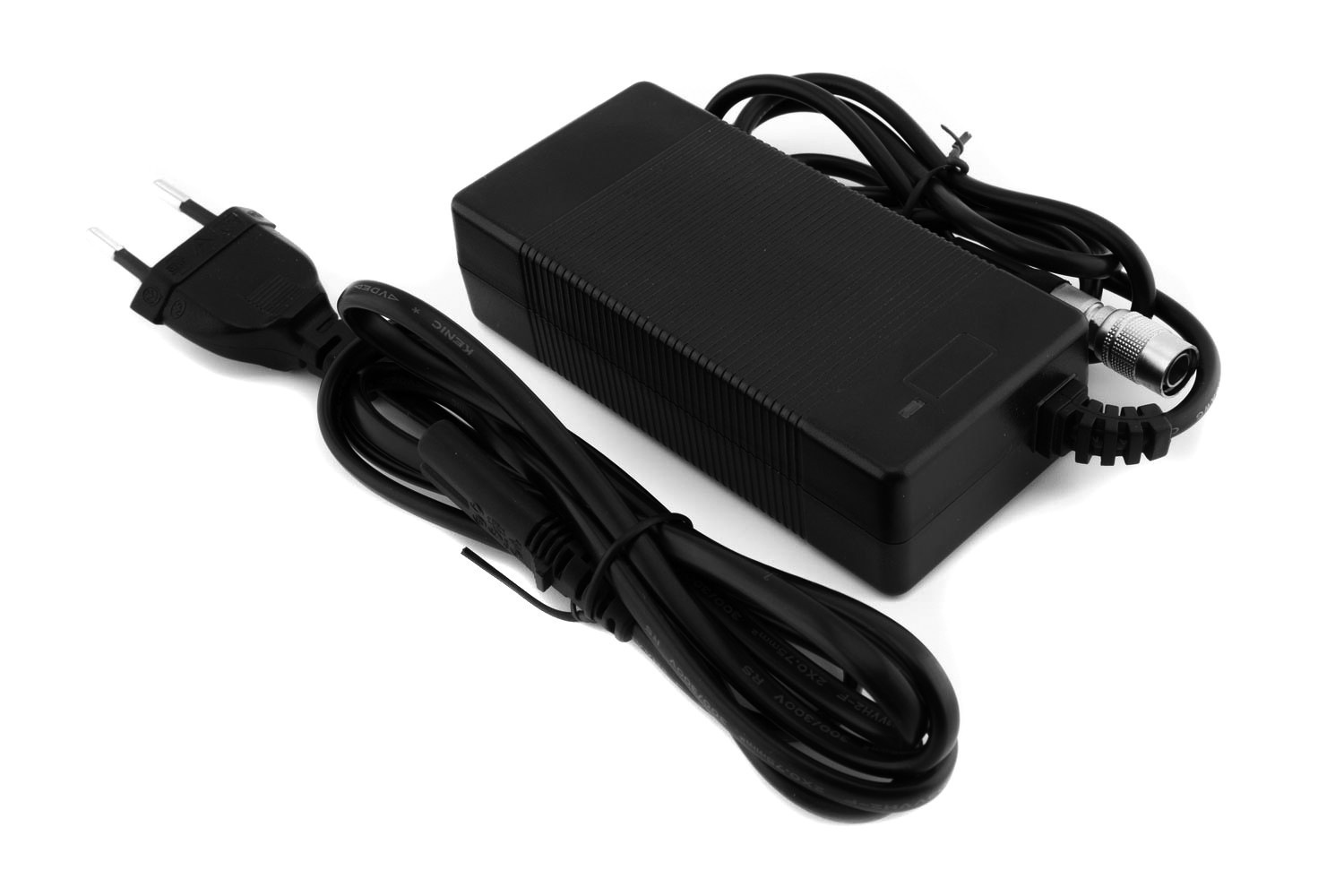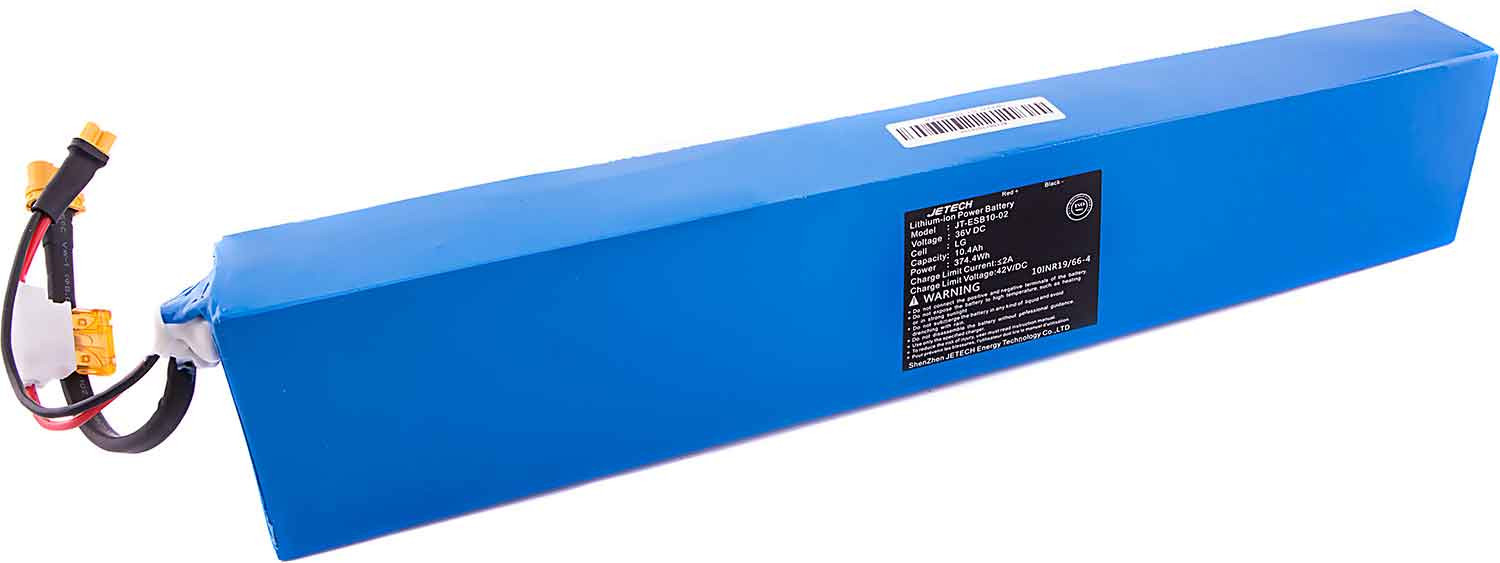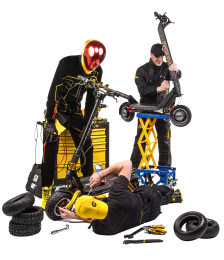Click for more results.
No produts were found.
Your cart is empty See the offer
Connect your charger to the mains first and only then to the scooter (disregard the fact that operating manuals sometimes incorrectly claim otherwise). It is the safest way to protect the charger and its output capacitors. The charger heats up while charging, which is normal. Place the uncovered charger on a non-flammable surface providing sufficient airflow.
After connecting the charger to the mains, connect the charger's plug to the charging port of your scooter. The scooter must be switched off and the charging port's protective cover must be removed. Make sure that both the port and the connector are free of dust and other debris. Blow off any dirt, if necessary. Make sure of the charger's correct polarity. Most chargers feature an arresting tab, which means they can only be inserted in one way. Use only original chargers. Third-party chargers may have phases connected differently in the charging connector, which may lead to short circuit.
Wait unit the scooter charges. Charge the scooter until the indicator on the charger turns green. After that, disconnect the charger as soon as possible. Disconnect the charger from the scooter first and only then from the mains! Charge as often as necessary. With most chargers, the indicator turns green before the scooter gets fully charged. If your scooter has a built-in voltmeter or a battery charge indicator is shown on the display, you will find out that you are not 100% charged. If you need maximum range, you may continue charging until reaching 100%. However, if you wish to significantly extend your battery life, operate the battery between 20% and 80% of its capacity. This is an ideal charging zone that significantly extend the battery's life.

With longer storage periods, such as during winter months, store the battery charged ideally at 40-60% of its capacity in a dry place and at room temperature. Storing fully charged or fully discharged lithium-ion batteries accelerates their degradation (shortens their life span). Due to self-discharging of the battery, check it regularly every 4-8 weeks and partially recharge it, if necessary. Storing a fully charged battery at extreme temperatures is particularly detrimental.
Charge the battery when its temperature is between 0°C and 45°C. The battery should definitely not be charged when its temperature might be below freezing point or immediately after riding when it is overheated. Before charging, wait until the temperature stabilizes within the above temperature range.
Do not leave the charger connected to the mains and the scooter after charging. Once the scooter is fully charged (or charged to 80%, as recommended), disconnect the charger in accordance with the instructions in point 3. Leaving the scooter connected to the charger and to the mains after charging leads to cathode corrosion and gradual battery degradation.
Do not fully discharge the battery in less than an hour. If you have a powerful scooter and you wish to ride fast, you will probably not be able to avoid discharging the battery quickly. When riding continuously at high speeds or when heavy torque is required, such as when accelerating up a steep hill, you can easily exceed the ideal discharge rate.
Do not fully charge the scooter in less than an hour. Lithium-ion batteries last more cycles if you charge them slowly. For optimal battery life, it is best to charge the battery for longer than 1 hour. With most standard scooter configurations, you will not be able to exceed the recommended charging rate, and this not even when using two fast chargers connected in series.

How long do electric scooter batteries last? Before losing a significant portion of their capacity, the batteries in electric scooters typically last about 300 to 500 charging cycles, between 5 000 and 40 000 km of range or 3 to 8 years in terms of time. The aforementioned values vary significantly depending on the quality of cells, battery size, how the battery is being treated, charging method and the overall care of the battery (see above points).
Because due to self-discharging, the battery cells continue losing their charge when in storage. A cell with voltage below 2.7V severely degrades and may in fact become unstable and, as a result, potentially dangerous.
The charger has an output capacitor that has a 0V potential, unless it is connected to the mains. If you connect a non-powered charger to the scooter's battery that is usually charged at 36V to 84V (depending on the scooter), a huge amount of current gets discharged into the capacitor which is at 0V. This may cause sparks and damage to the scooter's charging port and, in reality, to the entire charger. If you connect your charger to the mains first, you bring the capacitor voltage much closer to the battery voltage and the above phenomenon does not take place.
When fully charged, any additional charging causes metal lithium build-up on the battery's anode. This metal lithium gradually accumulates there and lowers the battery's capacity by blocking the flow of lithium ions and, consequently, electrons.
Over the next few days, we will contact you to fine-tune the details.
Over the next few days, we will contact you to fine-tune the details.
We work hard to provide you with the best experience possible.
Over the next few days, we will contact you to fine-tune the details.
We're sorry you don't have enough information about your order. We always try to continuously inform our customers about everything. Please fill in the information below and we shall get back to you as soon as possible, after checking the situation.
We are grateful for all positive feedback and recommendations. It motivates us in our everyday work.
We are sorry that something is wrong. Please provide the most accurate description of your situation so that we may check and resolve it promptly. Your complaint will be received not only by our employees but also by the management and owners of Max Blinker company.
Thank you for your message. We will get back to you as soon as possible.
Help us to improve. Do you have any suggestions?
Every nice word we hear from you will make us happy. Contact us.
Did you find any error in the text? We shall appreciate if you let us know.
Thank you for your message. We will get back to you as soon as possible.
 Professional service service@maxblinker.com +49 304 2208 222 Order a service Warranty online More info about the service
Professional service service@maxblinker.com +49 304 2208 222 Order a service Warranty online More info about the service  Escooter Guide Read our extensive guide on how to safely ride your electric scooter. It is full of information of interest to both beginners and advanced riders. Read the Guide
Escooter Guide Read our extensive guide on how to safely ride your electric scooter. It is full of information of interest to both beginners and advanced riders. Read the Guide  Independent Testing We scientifically verify manufacturers’ claims about range, performance and top speed. More info
Independent Testing We scientifically verify manufacturers’ claims about range, performance and top speed. More info Voltride meníme na Max Blinker
More info